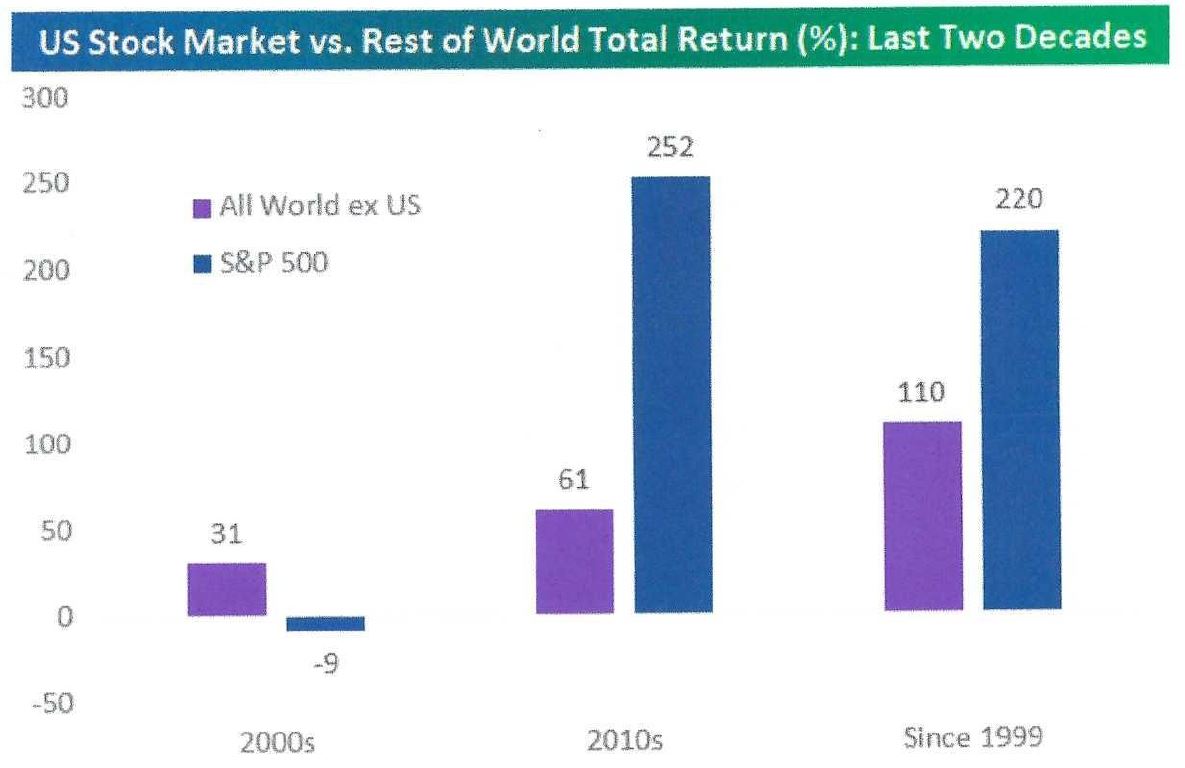
- Last week investors were reminded of risk – geopolitical risk to be specific. Stocks quickly sold off after tension between the U.S. and Iran escalated. But we don’t remember when there wasn’t ‘tension’ in the Mideast. Individual risks such as this tend not to be enough to drive stock prices long-term. Corporate profits and changes within the U.S. economy should remain the focus of investment decisions.
- If someone told you on January 1, 2019, that the year would start off with fears of an economic recession, the U.S. China trade war would heat up, and President Trump would be impeached, you may have asked, “How bad was the bear market going to be?” Well, there was no bear market in 2019 and not even a correction. The maximum drawdown was less than 7%. We are sure market timers are fit to be tied. How could the market go up in light of so much ‘bad’ news? We never said the market was rational.
- The annual exercise by Wall Street analysts to forecast the stock market is a waste of time in our view. They rarely get it right because there are too many moving parts. And it’s futile to anticipate how the market will react to key events. We subscribe to the wisdom of John Kenneth Galbraith who once said, “There are two kinds of forecasters: those who don’t know, and those who don’t know they don’t know.” Long-term earnings trends drive stock prices. But in the short-term, anything goes. For example, in 2018, S&P 500 earnings grew by 24%, yet the index fell 6.2%. In 2019, earnings look to dip about 1%, but the S&P 500 index was up 28.9% and the Dow 22.3%. But we will share analyst forecasts in order to take a look at their assumptions. Wall Street is looking for the stock market to appreciate 3.3% in 2020, well below historical averages. Since earnings growth estimates are almost 10% for the year, their assumption is that the P/E ratio will decline by about 1.5x. Seems pretty precise. But don’t fret. Over the last two decades, their estimates were off by over 4% per year on average.
- Valuations should be one of the biggest headwinds stocks face in 2020. The S&P 500 forward P/E ratio for this year is 18x compared to 15.1x for the long-term average. A retracement to the norm would be a 16% drawdown. Above-average valuations don’t mean the market can’t keep rallying, but future gains will more likely have to be driven by earnings growth rather than multiple expansion. In terms of book value, the S&P 500’s P/B ratio remains elevated at 3.5, which is well above the average of 2.5 going back to 1978. But today’s economy is a lot different. The largest companies in the S&P 500 are now a lot less capital intensive than they used to be, and therefore, higher multiples to book value can be expected.
OUR 2020 PLAYBOOK
There is nothing magical about the calendar turning over for investors, but a new year is the typical time to reevaluate strategy. Our strategy remains the same after a successful 2019 and can be summarized as follows. We plan to:
- Buy U.S. U.S. stocks have trounced foreign stocks over the last ten years and we expect that to continue. Some experts recommend buying international stocks because they are cheaper. They should be cheaper because they are lower quality than U.S. stocks. The spreads in valuation, however, aren’t wide enough for us to be tempted to buy foreign. Plus, the U.S. economy is doing better than most foreign economies. The following bar chart shows the dramatic outperformance of U.S. stocks over the last two decades.

Source: Bespoke Investment Group
- Stay diversified by sector but overweight growth cyclicals and consumer discretionary stocks. A very strong U.S. consumer should translate into good performance for consumer discretionary stocks (not to be confused with consumer staple stocks). ‘Growth cyclicals’ refers primarily to technology stocks. Investors go where the growth is, and that is in large part technology companies. We are underweighted in energy and consumer staple stocks. The world is awash in oil since the U.S. has become a major global supplier of oil yet energy stocks still trade at rich P/Es, and consumer staple stocks sport tech-like P/Es with very little organic growth.
- Pay attention to position sizes. Many investors fall in love with their best-performing stocks but should trim them back when they have grown to an outsized position. It is a matter of risk control. Bad things can happen to good stocks.
- Sell extremely overpriced securities in spite of tax consequences. If a stock is priced to perfection, it only takes one disappointment for it to come tumbling down. A couple of ‘torpedoes’ can have a big impact on total portfolio performance.
One thing we don’t do is time the market. We rebalance as needed (i.e., reduce the stock weighting if it exceeds an account’s maximum equity ratio) but always stay fully invested.
In summary, our goal is to remain patient but always follow our strict disciplines, especially on the sell-side. Selling stocks correctly is much more difficult than buying stocks. Successful portfolio management really comes down to disciplined risk management.
